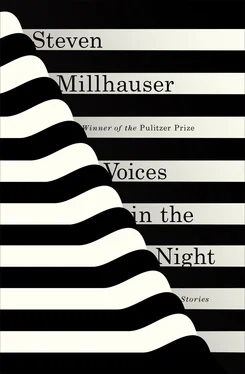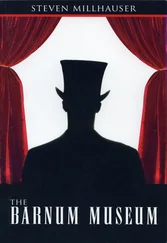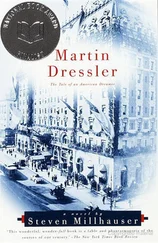—
Approaching the Yellow Bridge. A few days later, Gautama is walking on a path in the Park of Six Bridges. He is alone. In the near distance he catches sight of the Yellow Bridge, and as he recalls his recent stroll with Chanda an uneasiness comes over him. He can’t accuse himself of deliberately avoiding Chanda, but it’s true enough that he hasn’t sought out his friend in the old way. The estrangement puzzles him. The deep friendship that flows between them, the fierce closeness, the intimacy deeper than blood, the long nights of adolescence spent pouring out their souls — all this has come to seem oppressive to Gautama, who doesn’t want to walk beside a friend who glances at him anxiously, watches hungrily for signs, and observes him as one might observe a child leaning too far over a balustrade railing. Sometimes Chanda blurts out enigmatic half-questions that seem to hint at accusations or confessions. Gautama understands that he himself is partly to blame for this state of affairs, for lately he has felt in himself a kind of inward hiddenness, which is bound to provoke the anxious scrutiny of a friend, to say nothing of that friend’s sense of injury. After all, to whom should Gautama turn, in his obscure trouble, if not to Chanda? But Chanda’s urgent concern doesn’t limit itself to charged looks and riddling utterances. Gautama can feel, beneath those looks, some deeper turbulence. Can Chanda be concealing something from him? On several occasions recently, the Prince has had the peculiar sensation that someone is watching from a hidden place, and he cannot prevent himself from imagining that this unseen watcher might be Chanda. As he steps onto the Yellow Bridge, he looks back suddenly at the path. With self-disdain, with remorse, he returns his gaze to the bridge and looks down at the clear water, through which he can see white pebbles and red sand.
—
A Tremor of Whiteness. Chanda, walking along a path in the Park of Six Bridges, feels the smoothed earth press into his bare soles. He walks so quietly that he cannot hear the touch of his own feet on the path. Sometimes he stops, his body tense, his senses alert. Sometimes he picks up the pace. He crosses the Azure Bridge and continues along a path bordered on one side by a pond with wild geese and on the other by a grove of blossoming acacia trees. Sometimes, when the path turns, he sees a tremor of whiteness that disappears. Now the path turns again. Chanda follows the curve and stops — stops so completely that it’s as if he has come to a closed door. He does not breathe. Directly before him, on the Yellow Bridge, Gautama stands in his brilliant white dhoti and shawl, staring down at the Stream of Happiness. Chanda walks silently backward. He watches as the turn of the path gradually pulls the trees across the Prince, making him disappear.
—
The Ladder. Gautama crosses the Yellow Bridge and strolls along a shady path under a canopy of branches. If only he were a pebble in a stream! He tries to imagine himself as a pebble in a stream. He is cold and white and round and hard and still. The thought calms him. He wonders whether it is possible to be a discontented pebble in a stream. He imagines a pebble having dark thoughts in a stream. As the path begins to curve to the right, he thinks: My mind is absurd. I am absurd. He rounds the turn and sees ahead of him a high narrow ladder reaching up into the branches of an asoka tree. Near the top of the ladder stands a gaunt man, his face partly hidden by dark green leaves and pale orange blossoms. The man appears to be touching a leaf on a branch above his head. Beside his knees, on each side of the ladder rails, hangs a wooden basket. The man pulls the leaf from the branch, drops it into one basket, and removes from the other basket another leaf. With a needle and thread he carefully begins to attach the second leaf to the place where the first leaf hung. He does not look down as Gautama walks up to the ladder and stands there watching.
—
Chanda Continues on His Way. In the middle of the Yellow Bridge, Chanda stops for a moment to look down at the clear stream. He wonders what drew Gautama’s attention, down there where one sees only smoothly flowing water, white pebbles, and red sand. His friend sees other things, he’s sure of it, but they lie within. Chanda crosses the bridge and continues along a sunny-and-shady path that stretches away beneath a canopy of interlaced branches. He walks slowly, listening for the possible sound of his bare soles against the smoothed earth, but he hears only birdsong. Chanda has trained himself to walk so quietly that he can bend over a bird pecking at the ground and pick up that bird in his hands. As he walks, he glances quickly over his shoulder, but no one is there. Is he foolish to imagine that the King is having him followed? The King, after all, is having his own son followed. Before him, where the path turns out of sight, Chanda hears a clatter of distant cart wheels amidst the birdsong. He follows the turn of the path and stops abruptly. Gautama is standing beside a ladder, staring up. Chanda pauses, looks quickly about, and steps into the trees. The sound of cart wheels grows louder.
—
The Leaf Artist. Moments later a two-wheeled cart comes clattering into view, drawn by a bare-chested young man whose knee-length white loincloth is decorated with images of green leaves. The cart is filled with leaves so brilliant in their greenness that they appear to be wet. Upon seeing the Prince, the young man falls to his knees and presses his forehead to the path. Gautama bids him rise. The young man explains that he is an assistant to the Leaf Artist — he points to the man at the top of the ladder — who has been ordered by the Park Overseer to make leaves of green silk in his workshop, so that they may replace all leaves in the Park of Six Bridges that are in danger of falling. A report concerning a fallen leaf has caused great agitation. Now the Leaf Artist is passing from tree to tree, inspecting the leaves and replacing weak or damaged ones with sturdy leaves of silk. Gautama asks how many leaves are replaced in the course of a single day. The assistant answers that he doesn’t know the precise number of leaves, but he can say that this is the third cartload of silk leaves he has delivered to the park this afternoon. At the top of the ladder the Leaf Artist, awakened from his trance of concentration, glances down. When he sees who is standing at the foot of the ladder, he turns sideways and bows low, very low — so low that for a moment it appears he will fall from the ladder and strike the ground at Gautama’s feet. Slowly he uncurls and returns to his task.
—
Gautama’s Knee. Gautama returns from his walk in the Park of Six Bridges, enters his chamber, and sits on a floor mat. The afternoon has not been a success. He feels certain he was being followed, but he doesn’t know why anyone should follow him as he takes a stroll in one of his parks. There are many things he does not know. He doesn’t know why a leaf falls from a tree. He doesn’t know why he is a man and not a pebble in a stream. He doesn’t know why he is unhappy. Does he know anything at all? He looks at his left knee. What does he know? He knows nothing. Does he even know that he has a knee? A man should know whether or not he has a knee. He asks himself why he thinks he knows he has a knee. He thinks he knows he has a knee because he perceives a particular shape and color. But what if his eyes are deceiving him? What if he’s asleep? Say he closes his eyes and imagines a knee. Is that knee real? Is the outer knee more real than the inner knee? When he opens his eyes, the imagined knee disappears. Is it possible that when his eyes are open, as they are now, he is still not awake? And if he should wake? It’s warm in his chamber. His right eyebrow itches slightly.
Читать дальше












